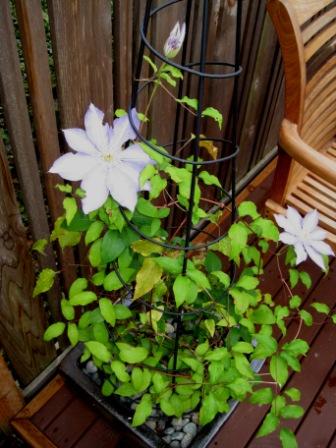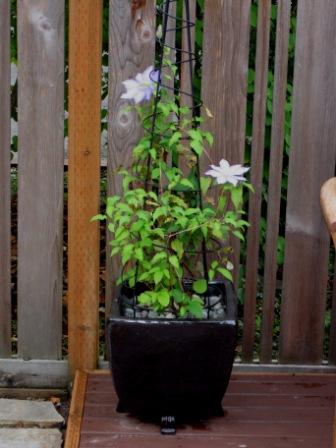Too often I’ve come across relatively young trees, shrubs, and vines that are surviving, but not thriving. Every year they struggle gamely to put on a few new leaves, grow a few more inches, but something’s fishy and it’s not fertilizer. Today I’m going to try to convince you to give these languishing woody species a second lease on life.
Long-time readers of this blog will remember some of the root horrors I’ve (literally) uncovered in containerized and balled-and-burlapped plants. Poor root quality, improperly amended soil, roots swaddled in multiple layers of materials, and root crowns sunk far below grade are some of the most common reasons why roots fail to establish after transplanting.
Fall can be a great time to correct these problems. For deciduous species, it’s best to wait until the leaves have fallen so that water needs are reduced. You can find basic instructions on how to install and care for woody plants on my web page.
There are other reasons that plants might not establish, too. You might remember my long-suffering Clematis, two which had been planted in an area with a perched water table. The lack of oxygen both retarded root growth and created an iron toxicity problem. I dug them up and transplanted them into containers (during which I had even more fun with overmixing the soil with water and then allowing the undersides of the leaves to sunburn). They were pretty sorry looking back in July – most of the leaves fell off after being burnt – but here they are just two months later:
So while you’re out putting your landscape to bed for the winter, take a close look for stragglers. Give their roots another shot at survival – you’ll be glad you did.


Good thoughts. I often find myself walking around my garden to the beat of “right plant, right location, right plant, right location.” Sometimes it does take more than one try to get it right.
You’ve inspired me! I just planted a few shrubs following your suggestion of getting a lot of potting mix off and pruning off any bad root growth (found some thick, hooked roots in the middle of the really fluffy potting mix) – can’t wait to see if these do better in the coming years than the shrubs I treated more gently. (Do you have any tips on the best way to get rid of the potting mix without doing too much root damage?) I was thinking of moving a shrub that’s just like you describe – sitting there for a few years, but not thriving or growing much, but was worried it might be too late in the
season. Any thoughts on how late it is safe to try this?
This post makes a ton of sense, seeing how plants are living organisms — sometimes it’s attention to the rooting conditions that makes all the difference between a plant merely existing and one that thrives.
You find all kinds of surprises when you wash the dirt off the root systems. Like when I washed the dirt off my Arbutus X ‘Marina’, and found it was all SAWDUST under the outer layer of roots and potting soil. Unfortunately, I dug it up, too late to save it. The root system had rotted from being too wet.
I still love your fence. Beeeeautiful!
Along those lines, a client came into MG Clinic grasping a puny clematis by its neck and asked what was wrong with it. Since much of what happens to a plant is owner induced trauma, he was asked about how he was growing it. Poor thing had been in the ground in two locations in two weeks. Told him to plant it and leave it alone.
I planned on moving a variegated Wegelia this fall, but with the drought the ground is too hard to dig. We are on a well so I don’t want to water the spot because we need the water for humans.